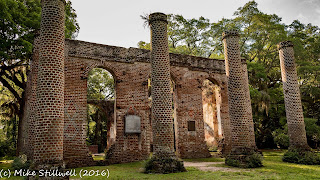On the way from our latest trip to Hilton Head we took a short detour by the Prince William Parish church on Old Sheldon Church Road in Yemassee. After seeing the pictures of this place I recognized from several pictures, videos, and movies that reference Sherman's burning of the South on his march to the sea. The following is some information I've gleaned from the interwebs about this church. It's a neat old place that is worth a stop if you happen to be in the area.
The Old Sheldon Church, formerly known as the Prince William Parish Church was built between
1745-1753 by William Bull whose plantation bordered the church grounds. The church was named Sheldon in honor of the family's ancestral home in England. The church was burned in 1779 by British troops during the Revolutionary War, and in 11826 was rebuilt. It's thought that in January of 1865, as part of Sherman's March to the Sea near the end of the Civil War that the church was burned a second time. Because of a letter dated 2/3/1866 by Milton Leverett , others think that the church was not burned but dismantled by the locals looking for materials to rebuild their homes that were burned by Sherman's army.
Sheldon Church is said to be the first
conscious attempt in America to imitate a Greek temple. The original
three-and-one-half foot thick colonnaded walls of Flemish bond and the
four all-header bond portico columns remain, attesting to the solid
construction and master craftsmanship which enabled it to withstand two
conflagrations and over two hundred fifty years of existence. The church was built along a row of seven Tuscan columns
- six engaged and one outstanding. The western facade had an elegant
portico, crowned by a triangular pediment with bulls-eye window and
cornice with dentils. The large front doorway had a fanlight above and
two round-headed windows, symmetrically spaced, on either side. On the
north, five bays between the engaged columns were filled with a single
tier of tall, round-headed windows; the other bay was left open for a
portico. At the eastern end, above the alter, was a Palladian window,
with a round-headed window to each side. Marble sarcophagi in the churchyard bear the names of South Carolina leaders.













No comments:
Post a Comment